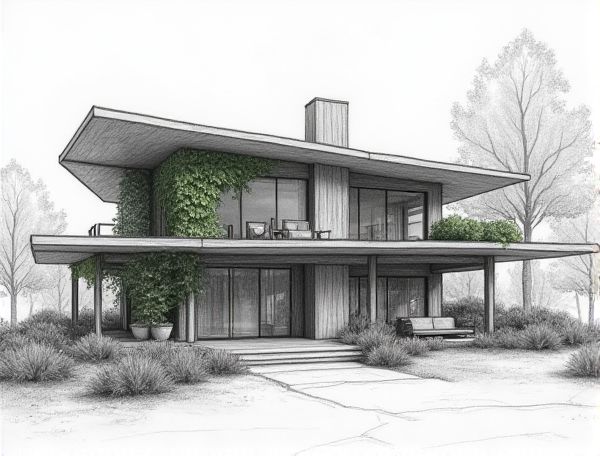
Photo illustration: Biophilic home design with integrated vertical hydroponic gardens
Integrating vertical hydroponic gardens into your biophilic home design enhances natural air quality and maximizes green space, promoting a healthier indoor environment that connects you to nature. Discover innovative ways to transform your living space with sustainable greenery by reading more in the article.
Introduction to Biophilic Home Design
Biophilic home design integrates natural elements such as sunlight, indoor plants, and organic textures to improve well-being and create a harmonious living environment. Incorporating features like green walls, natural materials, and ample ventilation enhances air quality and psychological health in residential spaces.
The Principles of Vertical Hydroponic Gardens
Vertical hydroponic gardens maximize space efficiency by growing plants upward using nutrient-rich water solutions instead of soil, ideal for limited indoor or outdoor areas. Maintaining proper water flow and oxygen levels ensures optimal nutrient absorption and healthy plant growth within compact vertical systems. Your vertical hydroponic design benefits from consistent light exposure and modular structure, promoting higher yields and easier maintenance compared to traditional gardening methods.
Benefits of Integrating Hydroponics Indoors
Integrating hydroponics indoors enhances your home design by maximizing space utilization and promoting sustainable living through soil-free cultivation. This method ensures fresh, pesticide-free produce year-round, improving indoor air quality and contributing to a healthier environment. Adopting hydroponics also boosts aesthetic appeal with vibrant greenery, creating a calming and modern atmosphere within your living space.
Key Elements of Biophilic Architecture
Natural light enhances your living spaces by promoting well-being and reducing energy consumption through strategic window placement and skylights. Incorporating indoor plants and natural materials like wood and stone strengthens your connection to nature, fostering a calming and rejuvenating environment.
Selecting Plants for Vertical Hydroponic Gardens
Selecting plants for vertical hydroponic gardens requires prioritizing species with compact root systems and fast growth rates, such as lettuce, spinach, and herbs like basil and mint. Nutrient requirements and light tolerance must be matched to the hydroponic setup to ensure optimal growth and yield. Incorporating vertical-compatible plants enhances space efficiency and maximizes available growing area in indoor or urban garden environments.
Space-Saving Solutions for Urban Living
Maximizing functionality in compact urban homes requires integrating multi-purpose furniture and vertical storage systems that optimize every inch of available space. Innovative designs such as foldable tables, wall-mounted shelves, and built-in seating not only enhance spatial efficiency but also maintain aesthetic appeal in constrained environments.
Enhancing Wellness Through Biophilic Design
Incorporating natural elements such as indoor plants, natural light, and organic materials enhances mental well-being and reduces stress in home environments. Biophilic design strategies improve air quality and foster a stronger connection to nature, promoting overall health and productivity.
Smart Technology in Hydroponic Home Systems
Smart technology in hydroponic home systems optimizes plant growth by using sensors to monitor nutrient levels, pH balance, and water temperature in real-time. Automated controls adjust lighting, irrigation, and airflow to create ideal growing conditions, reducing maintenance and maximizing yield. Your indoor garden benefits from increased efficiency and sustainability through these advanced, connected systems.
Sustainable Materials for Eco-Friendly Interiors
Sustainable materials such as bamboo, reclaimed wood, and recycled metal significantly reduce environmental impact in home design by minimizing waste and conserving natural resources. Incorporating low-VOC paints and natural fiber textiles enhances indoor air quality while supporting eco-friendly interiors. Utilizing energy-efficient insulation and sustainably sourced flooring further promotes a green living space that aligns with environmentally responsible home design principles.
Creative Ideas for Personalized Biophilic Spaces
Incorporating natural elements such as living walls, indoor gardens, and water features transforms home spaces into personalized biophilic environments that enhance well-being and creativity. Utilizing sustainable materials like reclaimed wood and natural fibers supports eco-friendly design while fostering a strong connection to nature. Customizing lighting with sunlight-mimicking LEDs and arranging furniture to maximize natural views further personalizes biophilic interiors, promoting tranquility and productivity.
 homedesy.com
homedesy.com